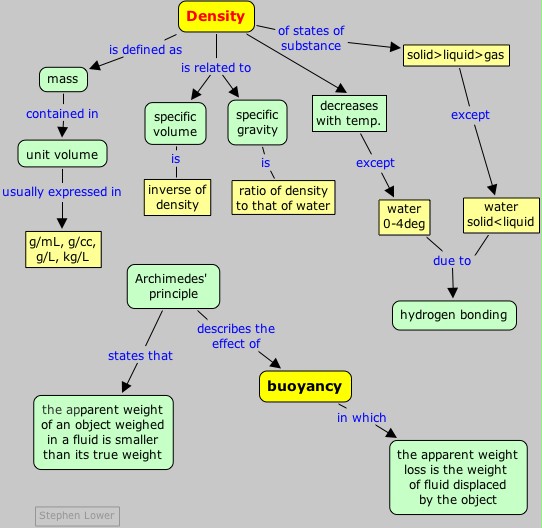Classification and properties of matter
The chemist's answer to "what is that stuff?"
On this page:
Matter is “anything that has mass and occupies space”, we were taught in school. True enough, but not very satisfying. A really complete answer is unfortunately beyond the scope of this course, but we will offer a hint of it in a later chapter on atomic structure.
For the moment, let’s put off trying to define matter and focus on the chemist’s view: matter is what chemical substances are composed of. But what do we mean by chemical substances? How do we organize our view of matter and its properties? These very practical questions are the subjects of this lesson.
The science of chemistry developed from observations made about the nature and behavior of different kinds of matter, which we refer to collectively as the properties of matter.
The study of matter begins with the study of its properties
By observing a sample of matter and measuring its various properties, we gradually acquire enough information to characterize it; to distinguish it from other kinds of matter. This is the first step in the development of chemical science, in which interest is focussed on specific kinds of matter and the transformations between them.
Extensive and intensive properties
If you think about the various observable properties of matter, it will become apparent that these fall into two classes. Some properties, such as mass and volume, depend on the quantity of matter in the sample we are studying. Clearly, these properties, as important as they may be, cannot by themselves be used to characterize a kind of matter; to say that “water has a mass of 2 kg” is nonsense, although it may be quite true in a particular instance. Properties of this kind are called extensive properties of matter.
This definition of the density illustrates an important general rule: the ratio of two extensive properties is always an intensive property.
Suppose we make further measurements, and find that the same quantity of water whose mass is 2.0 kg also occupies a volume of 2.0 liters. We have measured two extensive properties (mass and volume) of the same sample of matter. This allows us to define a new quantity, the quotient m/V which defines another property of water which we call the density. Unlike the mass and the volume, which by themselves refer only to individual samples of water, the density (mass per unit volume) is a property of all samples of pure water at the same temperature. Density is an example of an intensive property of matter.
Intensive properties are extremely important, because every possible kind of matter possesses a unique set of intensive properties that distinguishes it from every other kind of matter. Some intensive properties can be determined by simple observations: color (absorption spectrum), melting point, density, solubility, acidic or alkaline nature, and density are common examples. Even more fundamental, but less directly observable, is chemical composition.
The more intensive properties we know, the more precisely we can characterize a sample of matter.
Intensive properties are extremely important, because every possible kind of matter possesses a unique set of intensive properties that distinguishes it from every other kind of matter. In other words, intensive properties serve to characterize matter. Many of the intensive properties depend on such variables as the temperature and pressure, but the ways in which these properties change with such variables can themselves be regarded as intensive properties.
But we often encounter matter that is not uniform throughout, whose different parts exhibit different sets of intensive properties. This brings up another distinction that we address immediately below.
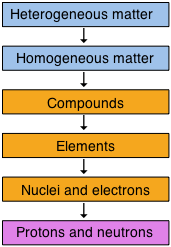
Alternatively, when we are thinking about specific samples of matter, it may be more useful to re-cast our classification in two dimensions:
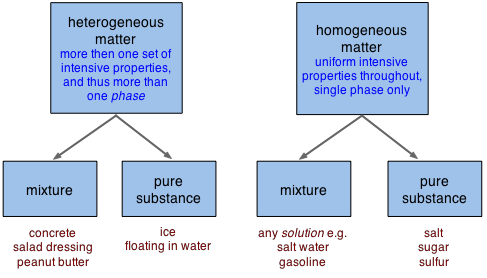
Notice, in the bottom line of boxes above, that "mixtures" and "pure substances" can fall into either the homogeneous or heterogeneous categories.
A much more thorough discussion of the classification of matter, and how it has changed since ancient times, can be found on this excellent page at the Chemogenesis site.
Since this latter schema covers virtually all matter that we encounter in the world, it is important that you thoroughly understand the meaning of each part of it. We will begin by looking at the distinction represented in the top line of the diagram.
Homogeneous and heterogeneous: it's a matter of phases
Homogeneous matter (from the Greek homo = same) can be thought of as being uniform and continuous, whereas heterogeneous matter (hetero = different) implies non-uniformity and discontinuity. To take this further, we first need to define "uniformity" in a more precise way, and this takes us to the concept of phases.
A phase is a region of matter that possesses uniform intensive properties throughout its volume.
A volume of water, a chunk of ice, a grain of sand, a piece of copper— each of these constitutes a single phase, and by the above definition, is said to be homogeneous.
A sample of matter can contain more than a single phase; a cool drink with ice floating in it consists of at least two phases, the liquid and the ice. If it is a carbonated beverage, you can probably see gas bubbles in it that make up a third phase.
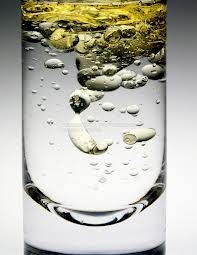
← The phase boundaries in an oil-vinegar salad dressing are easy to see...

...but those in milk are so small that they are only revealed by scattered light. →
Phase boundaries


Getting back to our classification, we can say that
Homogeneous matter consists of a single phase throughout its volume; heterogeneous matter contains two or more phases.
Dichotomies ("either-or" classifications) often tend to break down when closely examined, and the distinction between homogeneous and heterogeneous matter is a good example; this is really a matter of degree, since at the microscopic level all matter is made up of atoms or molecules separated by empty space! For most practical purposes, we consider matter as homogeneous when any discontinuities it contains are too small to affect its visual appearance.
How large must a molecule or an agglomeration of molecules be before it begins to exhibit properties of a being a separate phase? Such particles span the gap between the micro and macro worlds, and have been known as colloids since they began to be studied around 1900. But with the development of nanotechnology in the 1990s, this distinction has become even more fuzzy.
Pure substances and mixtures
The air around us, most of the liquids and solids we encounter, and all too much of the water we drink consists not of pure substances, but of mixtures. You probably have a general idea of what a mixture is, and how it differs from a pure substance; what is the scientific criterion for making this distinction?
To a chemist, a pure substance usually refers to a sample of matter that has a distinct set of properties that are common to all other samples of that substance. A good example would be ordinary salt, sodium chloride. No matter what its source (from a mine, evaporated from seawater, or made in the laboratory), all samples of this substance, once they have been purified, possess the same unique set of properties.
A mixture, in contrast, is composed of two or more substances, and it can exhibit a wide range of properties depending on the relative amounts of the components present in the mixture. For example, you can dissolve up to 357 g of salt in one litre of water at room temperature, making possible an infinite variety of "salt water" solutions. For each of these concentrations, properties such as the density, boiling and freezing points, and the vapor pressure of the resulting solution will be different.
Is anything really pure?

"9944100% Pure: It Floats"
This description of Ivory Soap is a classic example of junk science from the 19th century. Not only is the term "pure" meaningless when applied to an undefined mixture such as hand soap, but the implication that its ability to float is evidence of this purity is deceptive. The low density is achieved by beating air bubbles into it, actually reducing the "purity" of the product and, by diluting the soap with air bubbles, cheating the consumer.

Finally, we all prefer to drink "pure" water, but we don't usually concern ourselves with the dissolved atmospheric gases and ions such as Ca2+ and HCO3– that are present in most drinking waters. But these harmless "impurities" and are always present in those "pure" spring waters.
However, these and similar substances could seriously interfere with certain uses to which we put water in the laboratory, were we customarily use distilled or deionized water.
Even these still contain some dissolved gases and occasionally some silica, but their small amounts and relative inertness make these impurities insignificant for most purposes. When water of the highest obtainable purity is required for certain types of exacting measurements, it is commonly filtered, de-ionized, and triple-vacuum distilled. But even this "chemically pure" water is a mixture of isotopic species: there are two stable isotopes of both hydrogen (H1 and H2, often denoted by D) and oxygen (O16 and O18) which give rise to combinations such as H2O18, HDO16, etc., all of which are readily identifiable in the infrared spectra of water vapor. (Interestingly, the ratio of O18/O16 in water varies enough from place to place that it is now possible to determine the source of a particular water sample with some precision.) And to top this off, the two hydrogen atoms in water contain protons whose magnetic moments can be parallel or antiparallel, giving rise to ortho- and para-water, respectively.
The bottom line: To a chemist, the term "pure" has meaning only in the context of a particular application or process.
Operational and conceptual classifications of matter
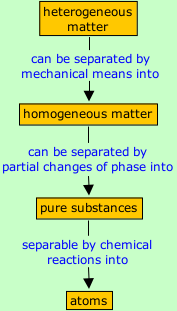
Consider a heterogeneous mixture of salt water and sand. The sand can be separated from the salt water by the mechanical process of filtration.

Similarly, the butterfat contained in milk may be separated from the water by a process called churning, in which mechanical agitation forces the butterfat droplets to coalesce into the solid mass we know as butter.
These examples illustrate the general principle that
Heterogeneous matter may be separated into homogeneous matter by mechanical means.
Turning this around, we have an operational definition of heterogeneous matter: if, by some mechanical operation we can separate a sample of matter into two or more other kinds of matter, then our original sample was heterogeneous.
To find a similar operational definition for homogeneous mixtures, consider how we might separate the two components of a solution of salt water. The most obvious way would be to evaporate off the water, leaving the salt as a solid residue. Thus a homogeneous mixture can be separated into pure substances by undergoing appropriate partial changes of state— that is, by evaporation, freezing, etc.
Note the term partial in the above sentence; in the last example, we evaporate only the water, not the salt (which would be very difficult to do anyway!) The idea is that one component of the mixture is preferentially affected by the process we are carrying out. This principle will be emphasized in the following examples.
Separating homogeneous mixtures
Some common methods of separating homogeneous mixtures into their components are outlined below.
Distillation
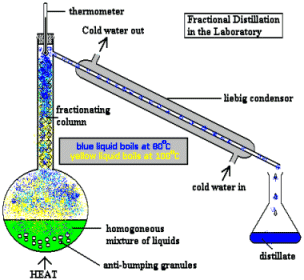
Note that if all the liquid were boiled away, the distillate would be identical with the original liquid. But if, say, half of the liquid is distilled, the distillate would contain a larger fraction of the more volatile component.
If the distillate is then re-distilled, it can be further enriched in the low-boiling liquid. By repeating this process many times (aided by the fractionating column above the boiling vessel), a high degree of separation can be achieved.
Fractional crystallization
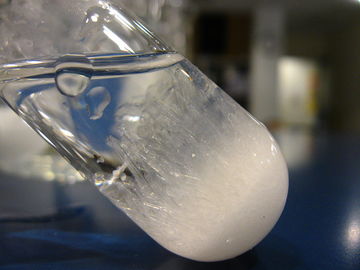
Similarly, a molten mixture of several components, when slowly cooled, will first yield crystals of the material having the highest melting point. This process occurs on a huge scale in nature when molten magma from the earth's mantle rises into the lithosphere and cools underground — a process that can take up to a million years. This is how the common rock known as granite is formed. Eventually these rocks rise and become exposed on the earth's surface.
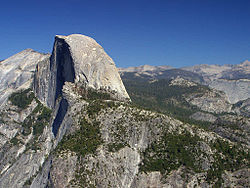

← A magnified image of granite shows the various components that have crystallized out over time as the melt gradually cooled.
Note that because the various components of granite are not removed as they crystallize out, they remain embedded in the solidified material.
Liquid-liquid extraction
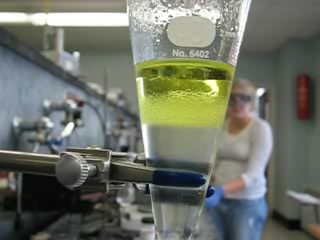
Solid-liquid extraction
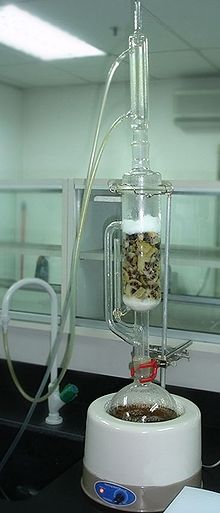

This, and similar extractions of the soluble components of complex solids, is carried out in an apparatus known as a Soxhlet extractor.
The idea is to continuously percolate an appropriate hot solvent through the material, which is contained in a porous paper "thimble". Hot vapor from the boiling flask bypasses the extraction chamber through the arm at the left (labeled "vapor" in the illustration →) and into the condenser, from which it drips down into the extraction chamber, where a portion of the soluble material mixes with the solvent. When the condensate reaches the top of the chamber, it flows out through the siphon arm, emptying its contents into the boiling flask, which becomes increasingly concentrated in the extracted material.
The advantage of this arrangement is that the percolation-and-extraction process can be repeated indefinitely (usually hours to days) without much attention.
[Image sources: left, Wikimedia; right, unknown]
This Wikipedia page shows a nice animation of the process.
(4 min), the capsaicinoids ("hot stuff") in peppers are separated and concentrated using a Soxhlet extractor.
Chromatography
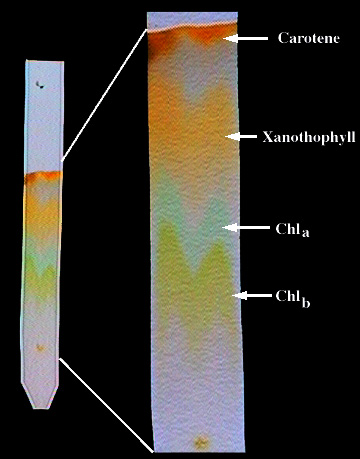
As a liquid or gaseous mixture flows along a column containing an adsorbant material, the more strongly-adsorbed components tend to move more slowly and emerge later than the less-strongly adsorbed components.
In this example, an extract made from plant leaves is separated into its principle components: carotene, xanthophyll, and chlorophylls A and B.
Although chromatography originated in the mid-19th Century, it was not widely employed until the 1950's. Since that time, it has encompassed a huge variety of techniques and is no longer limited to colored substances. Chromatography is now one of the most widely-employed methods for the analysis and separation of complex mixtures of liquids and gases.
>/
Since chemistry is partly the study of the transformations that matter can undergo, we can also assign to any substance a set of chemical properties that express the various changes of composition the substance is known to undergo. Chemical properties also include the conditions of temperature, etc., required to bring about the change, and the amount of energy released or absorbed as the change takes place. The properties that we described above are traditionally known as physical properties, and are to be distinguished from chemical properties that usually refer to changes in composition that a substance can undergo. For example, we can state some of the more distinctive physical and chemical properties of the element sodium: appearance: a soft, shiny metal density: 0.97 g cm3 melting point: 97.5°C boiling point: 960°C forms an oxide Na2O and a hydride NaH burns in air to form sodium peroxide Na2O2 reacts violently with water to release hydrogen gas dissolves in liquid ammonia to form a deep blue solution
Make sure you thoroughly understand the following essential ideas which have been presented above. It is especially important that you know the precise meanings of all the highlighted terms in the context of this topic.
- Give examples of extensive and intensive properties of a sample of matter. Which kind of property is more useful for describing a particular kind of matter?
- Explain what distinguishes heterogeneous matter from homogeneous matter.
- Describe the following separation processes: distillation, crystallization, liquid-liquid extraction, chromatography.
- To the somewhat limited extent to which it is meaningful, classify a given property as a physical or chemical property of matter.
